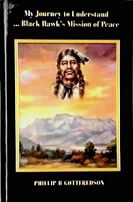
One of the more appalling stories from the Black Hawk War in Utah is the Grass Valley Massacre. The Timpanogos's account of the Massacre is that when the soldiers first approached their camp, the old Chief showed a soldier a paper from the Bishop of Glenwood that said they were friendly and no harm would come to them. He was the first one shot, and the soldier who shot him then beheaded him with his sword. The soldiers then surrounded the camp and opened fire on them, killing women, men, and children. Two managed to escape, and one little boy was found lying next to his dead mother and was taken custody by the soldiers.
The Old Chief Was Beheaded and Ten Timpanogos Murdered
Excerpt from Peter Gottfredsons book, Indian Depredations in Utah
On July 14, 1865 A. Robinson had been killed south of Salina
when he went to mill flour at Manti. He had made his way to Gravely
Ford with his wagon loaded with flour, where the two washes come together,
and the Indians had laid some brush across the stream and were
hiding there. When Robinson got within 30 feet of them, the Indians
opened fire hitting Robinson who then fell backward on to the sacks
of flour. The Indians then scalped him, stripped him of his gun and
belongings and poured flour over him.
The day before Robert Gillispie had been hunting horses south of
Salina with his friend Jake Harris. They were walking together when
they were ambushed by Indians, Gillispie was shot in the back
killing him. Harris managed to hide in a creek under some willows.
He said he was so close to Indians at times he could have reached
out and touched them. He hid there til night fall when he traveled
bare foot to Gunnison for help.
Hearing of the double murders, Gen. Warren S. Snow took command of a
hundred men and was soon on the march in pursuit of the Indians that
were now camped near Fish Lake. They stayed all day at Glenwood,
then before day break on the 18th they stopped to rest near a grove
of cedars in Grass Valley. What the soldiers didn't realize was a
Indian camp hidden from view that were in the cedars.
A Indian keeping guard on the camp saw a man standing covered in a
blanket, and when he could see that he was white he told the others
there were soldiers nearby. Among them a Chief said not to worry
that he had a paper from the Bishop of Glenwood that says they are
friendly and no harm will come to them.
When the soldiers realized they were camped in proximity to the
Indian camp is when the trouble began. According to one account an
Indian hiding behind a fallen log was first to fire on the soldiers
wounding one. That the soldiers then opened fire on the camp.
The Timpanogos account of the incident is that when the soldiers first
approached their camp, the old Chief showed the paper to one of the
soldiers, and he was the first one shot, and the soldier who shot
him then beheaded him with his sword.
The soldiers then surrounded the camp and opened fire on them
killing women, men, and children. Two managed to escape, and one
little boy was found laying next to his dead mother was taken
custody.
The soldiers believed this was the band that had killed Robinson as
they said they found some of his belongings in the camp. After the
massacre some soldiers wanted to look among the dead for guns when
the Colonel said " No let the squaws go hunt up their papooses." The
soldiers then left, but a few men stayed behind looking for guns and
rummaging through the dead for what other items of interest to them.
They reported later that only one escaped, that all were dead,
perhaps a dozen or more.
The Timpanogos story continues that their dead lay in the grove for a
long time until the white men took away their bones and remains.
When Brigham Young heard of the massacre he was furious, but as
before no action was taken against the aggressors. Every attempt was
made to keep the incident out of the papers for fear of the
government taking action against them, and may have interfered with
Utah achieving statehood. Eventually the word got around but
surprisingly nothing happened.
Note: This account is historically known as the "squaw fight" a derogatory term to the American Indian.
Phillip B Gottfredson changed the name to the "Grass Valley Massacre." The forgoing account is taken from historical records as they were
written, and does not reflect the attitude of this website our
anyone associated with it. We respect and honor the customs and
traditions of the First Nation peoples of Utah.
- Phillip B Gottfredson (Source: Indian Depredations in Utah)
Next: Timeline
|
